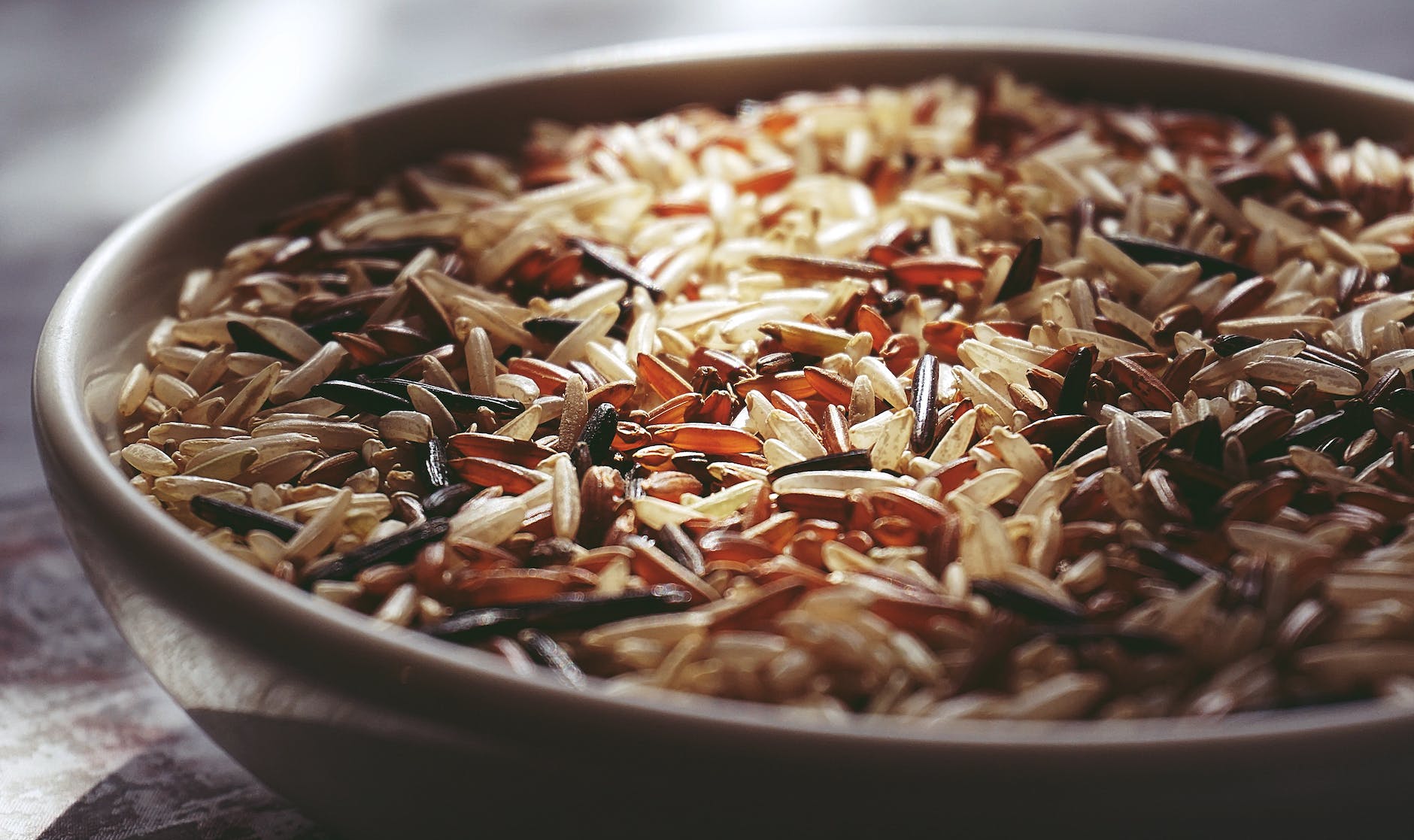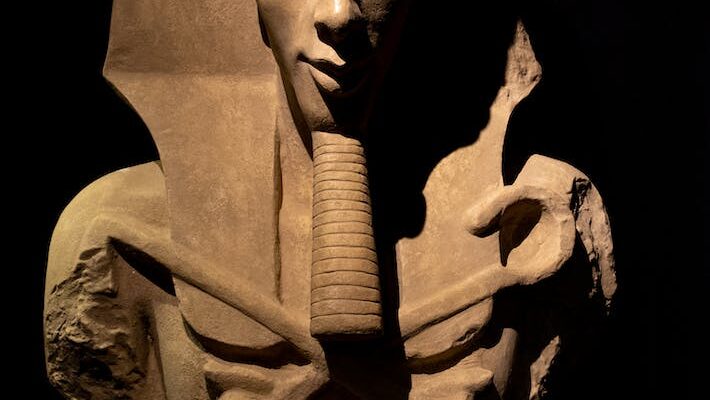Khorasan wheat (pronounced ka-moot) is a trademarked term for an ancient grain twice the size of normal wheat. Its origin story is quite intriguing. The grain originated in Egypt and was originally produced in the fertile crescent region between Egypt and the Tigris-Euphrates valley. A pilot uncovered some grains in an ancient burial tomb after WWII. As a result, it is often referred to as King Tut’s wheat or Pharaoh’s grain. These grains eventually found their way into the hands of a Montana wheat farmer, who sowed and harvested them. It evolved into the KAMUT® brand that we know today.
The name Kamut originated from the ancient Egyptian word for wheat. KAMUT® is distinguished by its trademark, which guarantees that the Khorasan wheat bearing is always of the original, unhybridized, and non-GMO kind. Kamut® Khorasan wheat is also organically certified and of the finest quality.

It was nearly extinct due to normal wheat, but it has recently regained popularity, along with other unspoiled ancient grains such as quinoa, teff, and buckwheat. Kamut® contains 20-40% more protein and fatty acids than wheat. It is referred to be a “high-energy grain” due to its greater lipid (fat) content. It also provides a number of health benefits. With its silky texture and nutty, buttery flavor, it is both nutritious and delightful.
Kamut’s distinct texture and flavor make it suitable for use in a variety of dishes ranging from salad to cereal and even beer. Furthermore, Khorasan flour (Kamut) can be used in baked goods that call for flour. It can also be used in place of regular flour in a variety of situations.
Kamut Nutritional Value
According to USDA data, 100 grams of uncooked Kamut contains:
- Energy: 337 kilocalories
- 2.13 g of fat,
- 14.5 g of protein
- 70.6 g of carbohydrate
- 11.1 g of Fiber
- 22 mg of calcium
- 3.77 mg of iron
- 130 mg of Magnesium
- 364 mg of phosphorus
- 403 mg of Potassium
- 5 mg of sodium
- 2.74 mg of Manganese
- 3.68 mg of zinc
- 6.38 mg of Niacin
- 81.5 mg of Selenium
The HealthifyMe Reminder
Kamut (Khorasan wheat) is a whole grain with high nutritional value. Although it is high in calories and carbs, the carbs are complex because it is whole grain. Furthermore, it is a good source of proteins, fiber, magnesium, phosphorus, potassium, selenium, and other nutrients, making it a healthy food.
Kamut Health Benefits
Among the most prominent advantages of this grain are:
Bone Growth and Preservation
Manganese is required for bone formation and preservation. Its absence can result in hypercholesterolemia and bone demineralization. It can also cause stunted growth in youngsters.
Manganese, which is abundant in kamut, improves bone metabolism. It helps in the maintenance of strong and healthy bones. Manganese-rich diets aid in the prevention of osteoporosis.
Consuming manganese may enhance bone mineral density in menopausal women and avoid signs of bone deterioration, according to research. To boost the benefits even more, combine Kamut with foods rich in calcium, zinc, copper, and manganese.
Digestive System Enhancement
Kamut contains a lot of fiber. Because fiber absorbs water and helps solidify stools, it promotes bowel movement and helps preserve gut health.
A fiber-rich diet may also lower the risk of colorectal cancer, according to research. Fibrous carbs also boost food absorption and make you feel full.

Kamut’s zinc content also improves digestion. Zinc deficiency is frequently related to stomach issues. Because zinc is crucial for the production of digestive enzymes, even a minor deficit hampers digestion. This grain is also easier to digest than most current wheat types. As a result, it is advantageous for persons who are allergic to wheat.
Reduces the likelihood of cardiovascular disease
Kamut reduces the chances of obesity, stroke, heart disease, high blood cholesterol, and diabetes while also supporting digestive health. It also promotes intestinal mobility, metabolic health, chronic inflammation, and the prevention of cardiovascular disease.
According to one study, a Kamut-based diet inhibits inflammation-promoting hormones while also lowering cholesterol and blood sugar. Raised cholesterol levels are one of the major causes of cardiac problems such as stroke.
Helps with Weight Loss
Fibre bulks up your diet. It keeps you feeling fuller for a longer period of time. Kamut’s protein content is also useful for weight loss. Protein digestion and metabolism aid in the burning of calories.
Protein also makes you feel full, which reduces your appetite. Protein also aids in weight loss by lowering fat and avoiding muscle loss and metabolic slowing.
Hormone control
Kamut contains antioxidants selenium and manganese, which protect against genetic alterations and cell membrane damage. Furthermore, selenium aids in the production of thyroid hormones, and manganese is essential in the processing of sex hormones.
Zinc, as an antioxidant, is required for the healthy functioning of both genders’ reproductive systems. It is in charge of controlling growth hormones.
Zinc has been shown in studies to help enhance or decrease testosterone levels in female reproductive system diseases. As a result, it alleviates PCOS symptoms. Zinc can also help to alleviate the pain associated with the menstrual cycle.
Detoxification of the Liver
Kamut is a good source of phosphorus. Phosphorus is required for kidney function and aids in the elimination of toxins from the body. It also has plenty of potassium and magnesium to balance uric acid, sodium, water, and fat in the body.
A study on the benefits of a Kamut-based diet on Nonalcoholic Fatty Liver Disease (NAFLD) found that this grain successfully decreases metabolic risk factors and improves the liver profile in NAFLD patients.
Enhances Brain Health
Niacin, commonly known as vitamin B-3, is found in kamut and is required for the production of various endocrine hormones as well as the health of the brain system. Niacin is required by your brain to obtain energy and function effectively. It also protects brain cells from damage and stress. Niacin deficiency, on the other hand, might result in memory loss and dementia.
Kamut’s manganese content also promotes cognitive function. Manganese is essential for regular cell function and metabolism, according to research. Manganese is also required for appropriate brain growth, according to scientific research.
Avoids the Common Cold
According to some research, zinc helps to keep mucus and germs at bay in the nasal passages. As a result, it may shorten the duration of the common cold by a day or two, lessen the severity of the symptoms, and avoid upper respiratory infections. Because it is high in zinc, Kamut can help prevent the common cold.

Encourages Thyroid Health
Manganese is responsible for the synthesis of thyroxine. Thyroxine is a necessary hormone for the thyroid gland to operate properly. Thyroid hormones regulate metabolism, hunger, weight gain, and organ efficiency. Kamut contains manganese, which can be included in your diet to help prevent thyroid problems.
Properties that are antioxidant and anti-inflammatory
Kamut bread, according to studies, has more antioxidants than current durum bread. Khorasan wheat also contained the most polyphenols and carotenoids.
Polyphenols protect the body’s tissues from pathologies such as cancer, coronary heart disease, and inflammation. Carotenoids contain anti-inflammatory and antioxidant effects. They also play an important role in shielding retinal tissue from light damage.
The HealthifyMe app Note
Kamut has a diverse nutritional profile. It is incredibly healthful, as well as having a gorgeous golden look and a buttery taste. It has a lot of protein, fat, vitamins, and minerals. It’s also high in zinc, magnesium, selenium, and a variety of polyphenols and fatty acids. As a result, it helps in weight control, cardiovascular risk reduction, bone and brain health improvement, and so on.
Methods for Including Kamut in Your Diet
Kamut is a versatile raw material since it may be used for a variety of purposes.
Kamut grains can be used in place of oatmeal for breakfast. Then, for a healthy and substantial breakfast dish, top with fruits, nuts, and honey or chocolate syrup.
Kamut grains can be added to soups and stews.
It can also be used as a salad topper. Cooked Kamut grains can be added to a cool, refreshing salad to take advantage of its protein and fiber content.
Kamut can be used to make baked products, bread, spaghetti, waffles, and pancakes. Its buttery flavor is ideal for bread.
By blending Kamut grains in a food processor, you can prepare porridge.
How to Get Ready
Soak them overnight to cut down on cooking time. Drain Kamut after soaking to prepare it for cooking.
Bring a pot of water to a boil (three cups of water for every cup of Kamut). Continue to boil the Kamut until the grains are mushy.
Before serving, remove the water. Kamut can also be cooked under pressure.
Click Here to Read Part 2 on Kamut the ancient egyptian grain
